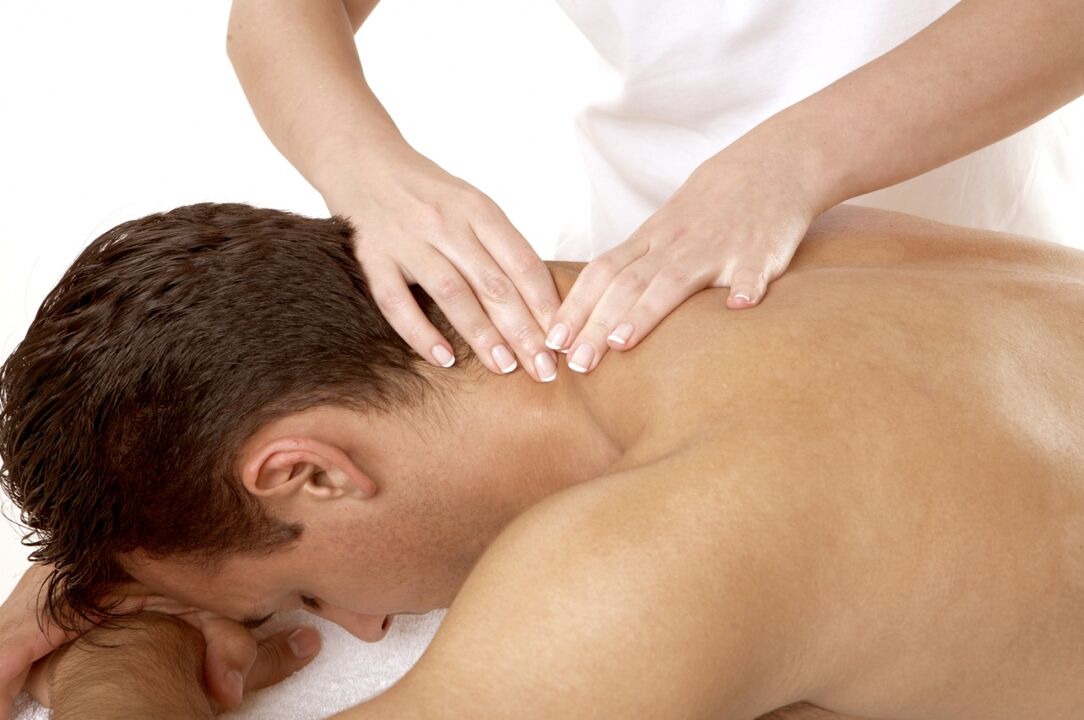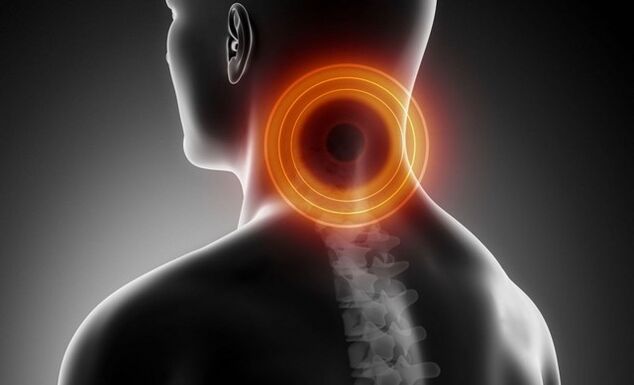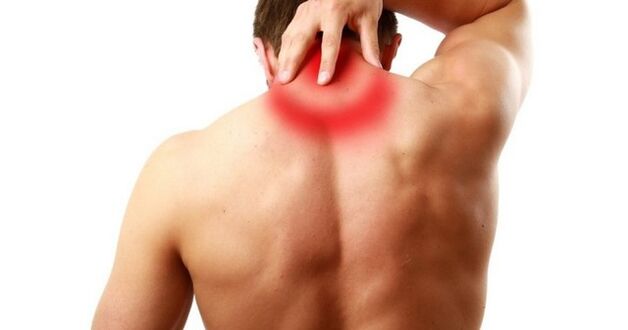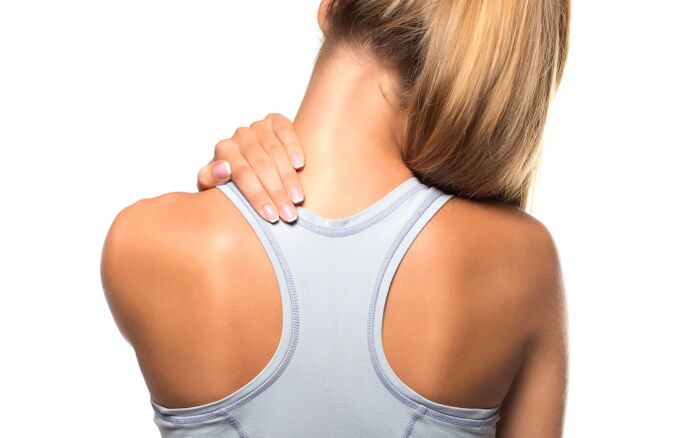
Osteochondrosis oftenoccurs in people with a sedentary lifestyletherefore, many are interested in how to relieve pain in cervical osteochondrosis at home.
The ability to eliminate pain at home
The main symptom that causes a person the greatest discomfort is pain. You can relieve pain yourself thanks to medicines, folk methods with herbs, massage.
Wellness gymnastics will also be useful.
Indications
Self-treatment of the diseasepossible with the following symptoms:
- headache;
- pain and stiffness in the cervical spine;
- dizziness.
Contraindications
Home treatment for serious signs of illnesscan lead to catastrophic consequences. . . If the following symptoms occur, you should consult a doctor:
- lack of coordination;
- memory loss;
- hearing loss, vision loss;
- loss of consciousness;
- anxiety and panic;
- interruptions in the work of the intestines and bladder.
Pain relief at home
One does not always manage to see a doctor, so one should resort to treatment at home.
This will help both drug therapy and folk remedies.
Medicines
There are drugs thatable to relieve pain and other symptoms of the disease. . . They can be applied topically and orally.
ethnoscience
In folk medicine are presented methods by which you can stop the pain syndrome and improve blood circulation.
There are also many recipes for relieving headaches with this problem.
Burdock recipe
You will need burdock leaves. 1 tbsp. dry crushed leaves are poured with a glass of boiling water and infused for half an hour.
This medicine is used as a compress. Apply on the affected area for 15 minutes. After the procedure, the neck should be wrapped in a warm scarf or shawl.
The tool will help relieve pain in the cervical spine.
Elderberry recipe
1/2 cup red elderberry is brewed in 2 cups of alcohol. The solution should be left in a dark place for a week.
The prepared solution is used to wipe the muscles of the neck. If you need a compress, then add 2 cups of water to this product.
Herbal recipes
Recipe number 1
You will need:
- chamomile - 100 g;
- parsley - 100 g;
- hops - 100 g;
- nettle - 100 g;
- burdock root - 200 g.
All herbs are pre-crushed and dried. Then place in a thermos and pour 1, 5 liters of boiling water. Infuse for 3 days.
The prepared strained solution should be taken in the morning and evening 1 tbsp. l.
The product is stored in the refrigerator.
Recipe number 2
You will need:
- burdock roots;
- dandelion roots;
- St. John's wort herb.
The ingredients are taken in equal proportions. 2 tbsp. the mixture of herbs is poured into 500 ml. water and boil for 2-3 minutes. The finished solution is filtered and used as compresses.
Relieves neck pain.
Recipes with honey
Recipe number 1
To prepare the mixture, you will need:
- liquid honey - 300 g;
- aloe juice (3: 1);
- lemon juice;
- almonds or walnuts - 500g.
The ingredients are mixed, the nuts must first be chopped. The finished mixture should be taken 3 times a day for 1 tsp.
The tool normalizes the work of metabolic processes, stimulates the body's immune response.
Strengthens the nervous system.
Recipe number 2
This tool is used for external use. For cooking you will need:
- potatoes - 1 pc. ;
- warm liquid honey.
Grate the potatoes and add honey. The mixture must then be mixed. The product is applied to the painful area, which is then wrapped on top with a food film and wrapped over it with a warm handkerchief or scarf. The duration of the procedure is 1-2 hours.
The agent reduces inflammation in the lesion.
massages
Soft massageapproved for use in severe cases. . . Gives noticeable results even when performing the procedure at home. You will need:
- carpet;
- Sharpener;
- tape (for self-massage).
Suitable massage methods
- Low impact on the affected area.
- The movements are directed from the spine.
- The movements are smooth and soft.
- Massage only with your fingers.
Massage with cups
The addition of canned food to the procedure normalizes blood circulation. Before starting the massage, the skin should be lubricated with a special oil or cream.
The duration of the procedure should not exceed 7-10 minutes.
Honey massage
Before the massage, the neck is warmed with a heating pad for 15 minutes. Then apply 1 tablespoon on the skin. l. honey. Gently massage the neck and shoulders until the hands begin to adhere to the skin. During the massage the honey will turn white, the skin will start to hurt slightly. The heated neck is covered with stretch foil and wrapped in a woolen scarf.
The procedure is recommended before bedtime. Honey should be washed in the morning.
Gymnastics and exercises
Special exercises in therapeutic gymnasticsare a preventive measure and a curative methodwith cervical osteochondrosis.
In order for the effect to be noticeable, the exercises must be performed systematically. Only daily exercise is guaranteed to lead to the expected results.
The exercises are divided into two groups and differ in body position during performance.
Exercise group number 1
- The pressure palm is applied to the forehead and the head is pressed against it in response, while the neck muscles must also work. The pressure lasts about 10 seconds. The exercise should be repeated 4 times and then the same is done with the back of the head.
- The palm should be applied to the left temple and the manipulations described in the previous exercise should be performed. Repeat with the right temple.
- The head should be thrown back, but not hard. By lowering your head, you need to significantly strain the muscles of the neck.
Exercise group number 2
- You need to lie down and pull your knees to your abdomen as much as possible (try higher). Then you need to raise your head and reach your knees. At the end of the exercise, the legs and head should be lowered slowly to the starting position.
- In this exercise, you should lie on your stomach and place your hands along your torso. Then you need to lift your head and shoulders. The lower body should remain still during this exercise.
- This exercise is performed on the abdomen, as well as the previous one. You need to spread your arms to the side and turn to the left, trying to touch your left palm with your right hand. The same should be done on the right side.
- While lying down, the chin should be placed on the palms of the hands connected in front of you, while the neck muscles should be relaxed. Then you should turn your head to the right and try to reach the floor with your ear. Then the exercise is performed on the opposite side.
Physiotherapy and massagers
In the treatment of osteochondrosis of the cervical spine, the use of physiotherapy, physiotherapy and massagers also shows good results.
Physiotherapyis available in the following types:
- Electrophoresis. This procedure relieves muscle pain and inflammation.
- Magnetic therapy. The procedures relieve pain and inflammation in the cervical spine.
- Ultrasound. The procedure relieves pain and inflammation with the help of ultrasound waves, which help to normalize metabolic processes.
- Vibration exposure. The effect of mechanical vibrations on the damaged areas helps to eliminate pain.
- Detent therapy. During the procedure, the spine is stretched by the weight of the body. This therapy helps to relax the muscles in the cervical spine.
To perform such procedures at home, you must purchase the following devices:
- Tape recorder;
- Vibrating belt massagers;
- Mattress with sloping ribs.
Prevent further development of the disease
To prevent the development of cervical osteochondrosis,it is necessary to take certain preventive measures. . .
Among the main preventive measures are proper nutrition and exercise.
Proper nutrition involves a special diet that includes some restrictions. These include a ban on the use of:
- spicy and salty foods;
- strong black tea, coffee;
- sweets;
- baking;
- carbonated drinks;
- mayonnaise;
- canned foods.
Exercise regularlywill reduce the possibility of disease recurrence to a minimum. . . It is necessary to find a suitable complex.
When conducting therapy at home, you must remember that any disease can be eradicated at an early stage.
If you already have severe symptoms of osteochondrosis, you should consult a doctor and stop further self-medication. It is important to remember that the disease is better prevented than cured. Proper nutrition and adherence to the daily routine not only contribute to recovery in the presence of disease, but also serve as a preventive measure.
How to get rid of neck pain with cervical osteochondrosis
Pain in cervical osteochondrosis occurs after prolonged static loads. To avoid painful attacks on the neck, you need to change your lifestyle - sit less, warm up more often, take time for physical activity. The vertebral arteries pass through the neck, supplying the brain with oxygen and other nutrients.

The carotid arteries start in the subclavian area, pass symmetrically along the line of the spine and then enter directly under the protection of the vertebral bone tissue. Closer to the head, they make a kind of loop so that the flow of oxygen is not suppressed as a result of rotations and movements of the head.
They then enter directly into the occipital region to ensure blood circulation to the brain.The system of vertebral arteries in the neck is designed so that if one of them is pinched, the brain will still survive at the expense of the other.
However, in this case many negative symptoms will still appear.
How seizures develop
When a person sits for a long time, the muscles atrophy, mainly the neck and lumbar muscles, pain and neck. There is a set of excess fat, because the calories have nowhere to go. Prolonged sitting in a sitting position in any case loads the cervical intervertebral discs. And especially if it happens all the time. The above-mentioned risk factors are added: muscle weakness and excess weight.
The cartilaginous tissues of the intervertebral discs of the neck do not recover, and their blood circulation is impaired by constant stress.They dry out and stop working as springs between the vertebrae. The height of the discs decreases, the vertebrae begin to touch each other as the head moves. Complications such as spondylosis, bulge, hernia may develop.
During sitting hours, muscle spasm of the neck develops. Muscles cannot withstand tension and contract to protect themselves. In this case, compression of the nerve roots may occur, cervical lumbago - cervicalgia.

In any case, the deformation of the intervertebral discs of the neck and muscle spasms in this area lead to the appearance of two main symptoms - pain and a feeling of stiffness.
If nerves are affected, sensitivity in the upper extremities may worsen.Such an unpleasant picture as compression of the vertebral artery can constantly develop.
The brain will no longer receive enough oxygen.
Exacerbations of osteochondrosis
Exacerbations occur in two cases - after waking up and long-term preservation of static posture, usually sitting. We are in the same situation at night.
And we often sleep on the wrong pillows - too high, soft, hard or, conversely, low. The shape of the pillow and its length can also be wrong.
As a result, the cervical spine remains unhealthy for several hours, the discs withstand compression and muscle spasm occurs.
After prolonged static position, osteochondrosis worsens. In addition, attacks of neck pain can occur after sudden movements, even such as sneezing, coughing, laughing.
Varieties of the pain syndrome
Cervical osteochondrosis leads to pain of various nature and origin. Thus, various sensations occur due to nerve compression, lack of oxygen, muscle spasms and deformity of the intervertebral discs. But these feelings always bring discomfort to the patient and require medical advice as well as subsequent treatment. How it hurts depends on the methods of pain relief.
Pain radiating to the arm
If the neck pain syndrome in the hands has acquired chronic features, it is most likely that there is a deformation of the nerve tissues in the neck.Osteophytes (bone growths on the vertebrae) are often to blame, which negatively affect the nerves that innervate the arms.

In this case, such an unpleasant symptom as paresthesia may occur. This is the name of a condition characterized by loss of sensitivity in the upper extremities. There are slight piercing sensations, the hands are numb, as if "goosebumps". The palms and fingers are particularly susceptible to paresthesia. Sometimes such symptoms occur in thoracic osteochondrosis.
Pain in the jaw and Adam's apple
Pain and stiffness in osteochondrosis of the cervical spine can be felt not only in the neck but also throughout the head.Pain can be given in the jaw, Adam's apple, ears.
Due to spasmodic muscle contractions, an unpleasant symptom appears - crunching of the jaw. The pain occurs the second the patient eats or speaks.
For these manifestations, doctors often prescribe muscle relaxants wearing a Shants collar.
Headache and lack of oxygen
Compressive or headaches occur suddenly and, as it seems to the patient, for no reason. Worse when moving the neck of the eyeballs. Painful sensations can develop in waves.
Exacerbations develop by the same mechanism as attacks of general pain in cervical osteochondrosis.
However, if you have a headache, it is likely that such a dangerous condition as compression of one of the vertebral arteries has occurred.
What can harm cervical osteochondrosis and how to treat it at home?
Nowadays, neck pain has become commonplace for many. It is associated with a sedentary lifestyle, constant inappropriate sitting at work and inactivity.

But few people know that such painit may not be as harmless as it seems at first glance. Such pain can hide serious diseases. I would like to talk about one of these diseases now. This disease is cervical osteochondrosis.
Cervical osteochondrosis - characteristics
Before starting treatment, it is necessary to understand the main detail - the characteristics of the disease.
Cervical osteochondrosis- degenerative-dystrophic disease that affects the intervertebral discs in the cervical spine. Such diseases most often develop in the most mobile parts of the spine, so the cervical spine is most often affected by the disease.
Let's take a closer look at the disease. The cervical spine has seven vertebrae that are interconnected by elastic intervertebral discs.
It is these discs that give mobility to the spine and also strengthen it. Each disc consists of a fibrous ring with a pulpal nucleus inside.
With the appearance and development of osteochondrosis, the intervertebral discs lose their elasticity and a huge amount of fibrous ring is loaded. In this regard, it swells and cracks. The reason for this is metabolic disorders in the spine.
The unique composition of the cream is a source of important building blocks for the joints. Effective in combating many joint diseases.
Ideal for both prevention and home treatment. It has antiseptic properties. Relieves swelling and pain, prevents salt deposition.
Causes of the disease
Now that we have a common understanding of the disease, it is necessary to understand the reasons for the appearance and development of this disease.
Let's take a closer look at the list of all possible reasons:
- Sedentary way of life.Nowadays, most people spend all day sitting in front of their desk monitors.
This causes a kind of stagnation that leads to disease. It also gets worse if a person does not hold the spine properly. - Metabolic disease.Metabolic disorders can lead to many adverse effects throughout the body. If such problems occur, it is necessary to try to restore the metabolism as soon as possible.
- Deposition of salts in the cervical spine. . . Salt deposition is characterized by crunching when turning the head or moving the neck. Oddly enough, the main reason for salt deposition is unhealthy and unbalanced diet.
It must be said that the disease most often develops in the presence of several causes at once.
Let's look at the main risk groups:
- People who have suffered serious injuriesor surgery of the cervical spine.
- Hereditary predisposition.If parents and grandparents have similar problems, then there is a high probability of inheriting such diseases.
- Hypothermia. In fact, walking without a scarf in cold weather can cause such a disease. In addition, you do not need to be cold for many hours.
- Hormonal disorders and metabolic problems.Most often, these two problems are related. Treatment of hormonal disorders is an expensive process, but if they are neglected, then the treatment of the consequences will be much more expensive and will take much longer.
- Passive lifestyle.This includes office workers, people who spend a lot of time in front of the monitor, and also while driving. In such situations, the disease develops quite slowly, but should not be ignored.
- Joint pain can occur at any age, giving a person unpleasant sensations and often severe discomfort.
- Prevent the development of joint diseases, take care of them today!
- In such cases, our readers recommend the use of the latest cream - Hondrocream. . .
- It has the following properties:
- Relieves pain syndrome
- Promotes the regeneration of cartilage tissue
- Effectively relieves muscle hypertonia
- Fights swelling and eliminates inflammation
Symptoms
Once we have dealt with the causes of the disease, let's move on to the symptoms. It is pronounced and it is quite difficult to confuse with other diseases.
- Neck pain.The most important symptom that always appears, starting from the first stages. Pain most often occurs either as a result of exertion. These pains may be accompanied by pain in the arms and shoulders.
- headache.Headaches also become a constant companion. The pain always starts in the back of the head and then spreads throughout the head.
- Numbness, numbness of the hands,as well as pain and burning in the area between the shoulder blades. This may not happen regularly or it may not happen at all. However, the presence of such symptoms is a serious reason to go to the doctor.
- Cracking in the neck.Characteristic crunch when turning the head or neck. It is important to understand that a healthy person can have a crunch. In osteochondrosis, the crunch of a person's neck occurs constantly (may pass after charging).
- Darkening of the eyesand sometimes even loss of consciousness during sharp turns. It can also occur when rising abruptly from a sitting or lying position.
Symptoms usually appear gradually,but there are several of them at once. For example, almost every day there is pain in the neck and headache in the back of the head. In the morning, a strong crunch in the neck, which may be accompanied by pain.
The degree of the disease
There are a total of three main stages of cervical osteochondrosis. Let's look at each one individually and also understand their characteristics.
- First degree.In the first degree, severe and sharp pains appear, which often resemble an electric shock. From a medical point of view, cracks form in the fibrous ring.
Treatment at this stage can be with or without surgery. - Second specialty.The second degree is a continuation of the first, if you do not engage in treatment. At this stage there is a violation of the connections between the vertebral discs, which leads to a reduction in the distance (lumen) between the vertebrae.
The end of the second stage is complete drying of the fibrous ring. The treatment of the second stage is almost always performed with surgery. In addition, the patient is prescribed special compresses and a set of exercises. - Third stage.The most advanced stage is also called acute osteochondrosis. The pain becomes constant, numbness of the limbs often occurs, and the functioning of the vestibular apparatus is often disturbed.
As a result, the person may lose control of the limbs. From a medical point of view, the third stage is a complete rupture of the vertebral body. Manual therapy at this stage does not give any effect, therefore only spinal surgery is performed here.
It must be said that from the onset of the first painand symptoms often take a long time before the first stage. At this time it is best to start treatment. It does not require special investment of money and time, and is also completely safe.
The disease can be diagnosed only by examination by a specialist, but treatment can be performed at home
Possible complications
In addition to increasing pain and discomfort, cervical osteochondrosis can lead to a number of serious disorders and problems:
- The formation of an intervertebral hernia. It is characteristic of the third stage of the disease. You can get rid of it only through surgery. Such a hernia often does not pass without consequences.
- Vascular disorders. Probably the worst consequence that can lead to disability.
The fact is that in the human spinal cord there is a whole system that is responsible for blood pressure, heart function and motor skills of the upper extremities.
With serious disorders and injuries, a person can develop serious cardiovascular disease, as well as partially or completely lose control of the upper extremities.
Prevention
Consider a number of preventative measures that prevent cervical osteochondrosis:
- Active lifestyle.
- Chargers for the neck and spine.
- Healthy eating.
- Regular hot shower (can be replaced by a trip to the sauna or bath). Allows you to relieve muscle spasms.
- Keep your back and head straight when sitting at a table.
- Sleep on orthopedic mattresses and pillows.
- Choose chairs and armchairs that support your spine.
Conclusion
In conclusion, we note that there are no drugs that can permanently cure cervical osteochondrosis. In the new generation of medicine there are enough different drugs that eliminate the pain syndrome, relieve inflammation. But treatment must be long-term. In this case, you will be able to lead a normal life.



































